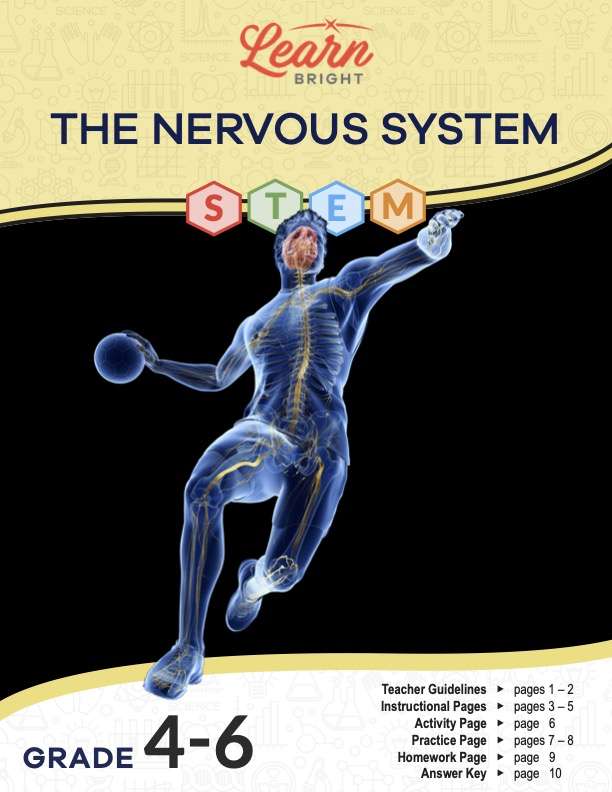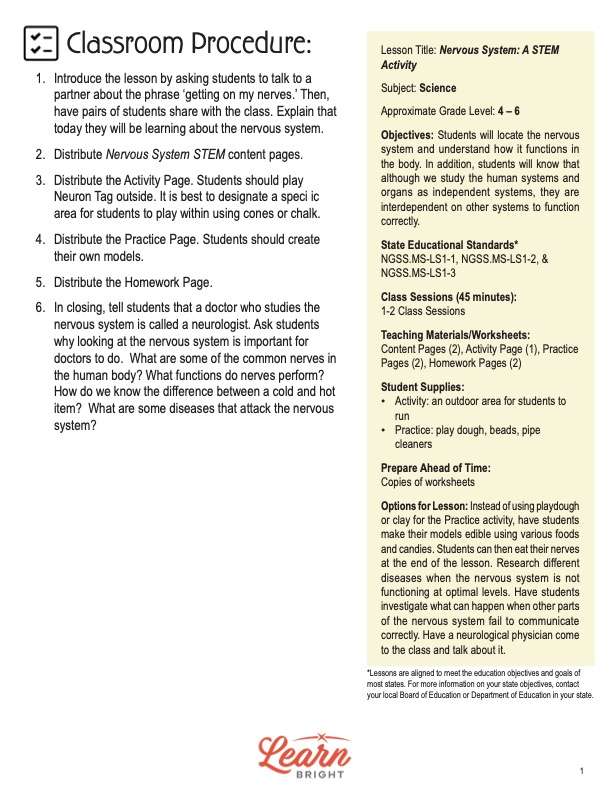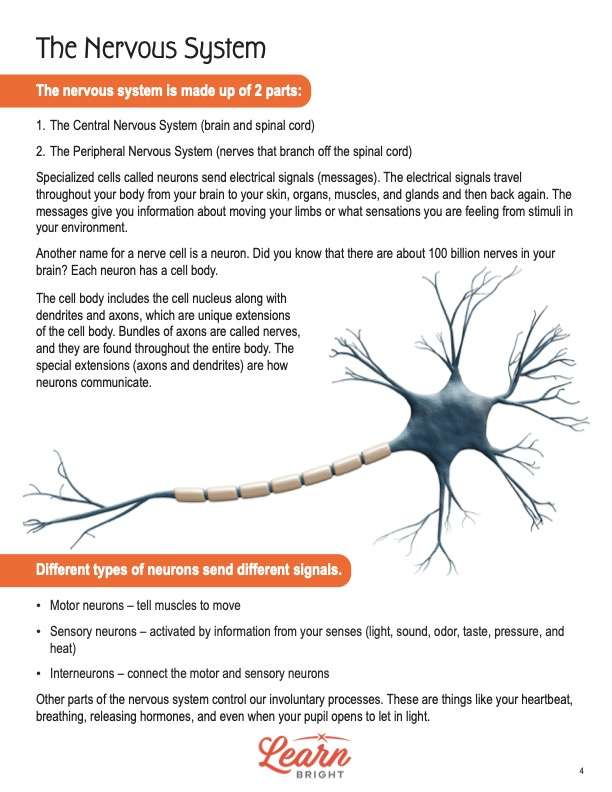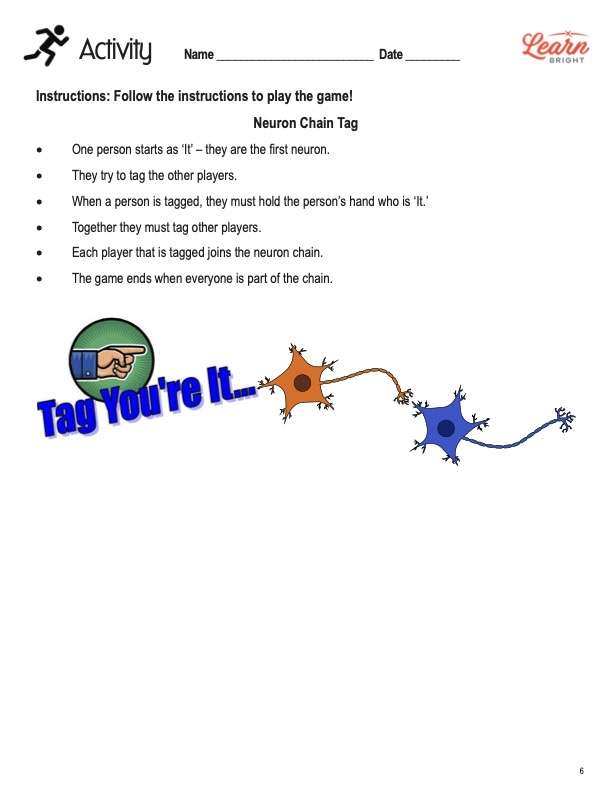Description
What our Nervous System STEM lesson plan includes
Lesson Objectives and Overview: Nervous System STEM teaches students how to locate and understand the functions of the body’s command center. Students will also learn about diseases that result from problems with the nervous system. They will also discover how it interacts with the body’s other systems. This lesson is for students in 4th grade, 5th grade, and 6th grade.
Classroom Procedure
Every lesson plan provides you with a classroom procedure page that outlines a step-by-step guide to follow. You do not have to follow the guide exactly. The guide helps you organize the lesson and details when to hand out worksheets. It also lists information in the yellow box that you might find useful. You will find the lesson objectives, state standards, and number of class sessions the lesson should take to complete in this area. In addition, it describes the supplies you will need as well as what and how you need to prepare beforehand. For this lesson, you will need play dough, beads, and pipe cleaners.
Options for Lesson
You can take advantage of the suggestions in the “Options for Lesson” section that offers additional activities or ideas to incorporate into the lesson plan. Instead of using play dough or clay for the Practice activity, have students make their models edible using various foods and candies. Students can then eat their “nerves” at the end of the lesson. Research different diseases when the nervous system is not functioning at optimal levels. Have students investigate what can happen when other parts of the nervous system fail to communicate correctly. Have a neurological physician come to the class and talk about it.
Teacher Notes
The paragraph on this page provides a little more information or guidance on what to expect from the lesson. You can use the blank lines to record any thoughts or ideas you have as you prepare.
NERVOUS SYSTEM STEM LESSON PLAN CONTENT PAGES
What Is the Nervous System?
The Nervous System STEM lesson plan contains three pages of content. A command center is a central place for carrying out orders and for supervising tasks. And that’s precisely what your nervous system does. It oversees and regulates almost everything you think, do, say, and feel. In addition, it controls your movements and automatic responses to stimuli around you. It also controls bodily functions like digestion, breathing, blushing, and even blinking.
In fact, the nervous system affects every other system in your body and every aspect of your health. These include learning and memory, balance and coordination, the five senses, sleeping, healing, and aging. The nervous system is a massive network of nerves that send electrical signals all over your body through cells, glands, and muscles. Your nerves receive information then interpret the information and create a response.
There are three main functions of the nervous system. The first is to keep the body in balance, or at homeostasis. Second, the nervous system is responsible for sending and receiving messages about the world around you. Finally, this body system controls your movements. Have you ever seen a picture of the highway system running through a big city? Your nervous system is a super information highway running throughout your body!
Parts and Process
Your nervous system comprises two parts: the central nervous system and the peripheral nervous system. The central part refers to the brain and spinal cord. And the peripheral part include all the nerves that branch off the spinal cord.
Specialized cells called neurons send electrical signals (messages). The electrical signals travel throughout your body from your brain to your skin, organs, muscles, and glands and then back again. These messages offer information about moving your limbs or what sensations you feel from stimuli in your environment.
Another name for a nerve cell is a neuron. Did you know that there are about 100 billion nerves in your brain? Each neuron has a cell body. The cell body includes the cell nucleus along with dendrites and axons, which are unique extensions of the cell body. Bundles of axons are called nerves, and they are found throughout the entire body. The special extensions (axons and dendrites) are how neurons communicate.
Signals and Communication
Different types of neurons send different signals. Motor neurons tell muscles to move. Sensory neurons become activated by the senses (light, sound, odor, taste, pressure, heat). And interneurons are those that connect the motor and sensory neurons. Other parts of the nervous system control our involuntary processes. These are things like your heartbeat, breathing, and releasing hormones. It also controls your pupils when they open to let in light.
When a neuron wants to communicate with another neuron, it sends an electrical signal down its axon. The myelin sheath is a layer that forms around nerves so the electrical impulses can travel quickly and efficiently along with the nerve cells. If it is damaged, these electrical signals slow down.
At the end of the axon, the signal changes from electrical to chemical. Special chemicals called neurotransmitters are released into the gap (the synapse) between the neuron’s axon and the other neuron’s dendrite. The dendrite converts the chemical signal back to an electrical signal. It travels through the cell body and down the axon to the next neuron in line. This process continues through thousands and millions of nerve cells.
Sometimes this process gets interrupted and doesn’t work perfectly. When this happens, it creates different disorders and conditions for people. Diseases, accidents, and toxins can all damage your nervous system. Even just growing older can damage the nervous system. There are different levels of damage, though. Sometimes your nerves cannot send or receive messages. Or there could be numbness in an area of the body, or it might be challenging to move a specific part of the body.
It is important to keep your nervous system healthy because it is the command center of your body. You can keep it working correctly by sustaining a healthy diet, avoiding drugs, and managing any medical conditions you might have with the help of a doctor.
NERVOUS SYSTEM STEM LESSON PLAN WORKSHEETS
The Nervous System STEM lesson plan includes three worksheets: an activity worksheet, a practice worksheet, and a homework assignment. Each one will help students solidify their grasp of the material they learned throughout the lesson. You can refer to the classroom procedure guidelines to know when to hand out each worksheet.
NEURON CHAIN TAG ACTIVITY WORKSHEET
Students will all work together for the activity as they play a game of neuron chain tag. One person will start as “it” and consider themselves the first neuron. They will try to tag other players. Once tagged, the other players must hold on to the first neuron’s hand, the second neuron’s hand, and so on. Each player that gets tagged joins the neuron chain. The game ends when everyone is part of the chain.
CREATE A NEURON MODEL PRACTICE WORKSHEET
The practice worksheet gives students an opportunity to create models of neurons using basic materials. Their model should include all the parts of a neuron, including dendrites, axons, a cell body, and so on. The worksheet page provides examples of handmade neurons for reference. In addition, it suggest you research “Brain Awareness Week” to find other ideas for fun activities.
NERVOUS SYSTEM STEM HOMEWORK ASSIGNMENT
For the homework assignment, students will draw their nervous system on the model on the worksheet. They must label specific parts: brain, spinal cord, arm nerves, leg nerves, abdomen nerves, and chest nerves.
Worksheet Answer Keys
The lesson plan document provides answer keys for the practice and homework assignments. On the practice homework, you will find a sample of what students’ models should roughly look like. Ensure they know to use different colors for the different parts of a neuron. On the answer key for the homework assignment, you will find a rough sketch that shows where certain nerves should be. Students’ work may sightly vary, but make sure they label correctly and have nerves in all the necessary parts of the body. If you choose to administer the lesson pages to your students via PDF, you will need to save a new file that omits these pages. Otherwise, you can simply print out the applicable pages and keep these as reference for yourself when grading assignments.









